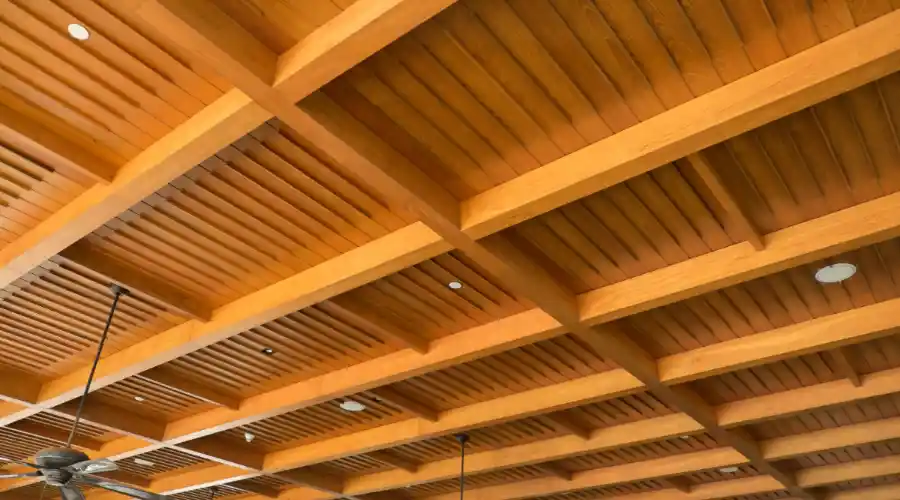Have you ever thought about how the ceiling can actually affect a room’s mood? It is usually neglected, but the right ceiling panels can really change a room. They can also be great when looking for beauty and practicality in one product-these should give you a very easy and affordable way to change your environment: modernism, antique finishes to ceiling panels, each room can create an entirely new experience in terms of aesthetics and comfort in ways that you wouldn’t expect.
What Are Ceiling Panels?
Ceiling tiles or ceiling panels are lightweight construction materials used for ceiling cover. They are installed in metal or aluminium grids and, while providing some thermal insulation, are primarily designed to enhance the aesthetics and acoustics of a room. They are often employed in commercial, residential, and industrial works, such as retail stores, offices, hotels, hospitals, and more.
Types of Ceiling Panels
Plaster of Paris Ceilings
PoP ceilings are highly embellished and personalized. They are made from gypsum and can form intricate shapes, such as arches and cornices. In addition to being durable, soundproof, and fireproof, PoP ceilings are commonly used in bedrooms due to their properties. These ceilings complement high-end interior treatments while also providing thermal insulation, adding both classiness and safety to residential and commercial buildings
Gypsum Ceilings
Gypsum ceilings are very light, fire-retardant, and can be easily installed. With mineral gypsum in the fabrication, Gypsum False Ceiling solutions provide smooth finishes and sound insulation. It can complement many other substances where both aesthetic value and durability are crucial. This is one of the most popular ceiling solutions that offer both safety and cost efficiency without sacrificing the modern interior looks.
Wood Ceilings

Wood ceilings bring warmth and texture to any room, making wood ceiling tiles an ideal choice for both rustic and contemporary designs. Reclaimed wood species such as oak, pine, and teak have their own aesthetic and sound absorption characteristics. Wood is among the few long-lasting materials which blend in making a cosy interior space, being eco-friendly.
Fibre Ceilings
Fibre ceilings, made from either mineral fibre or glass wool, such as Mineral Fiber Ceiling Tiles, provide soundproofing. They are lightweight, inexpensive, easy to install, and require little maintenance. They are available in a variety of custom designs and textures, making them really special. Such ceilings work great in throwing light at the same time in the way that multiple reflections take place. They are very much recommended for use in functional places like offices, schools, hospitals, and others.
Metal Ceilings
Metal Ceiling Tiles, made with aluminum and steel, offer long-lasting durability, require very little upkeep, and provide fire resistance, making them ideal for clean, modern industrial or contemporary interior spaces. They enhance a room with a reflective quality, and openness, and are easy to clean. With moisture and corrosion resistance, it’s good for those areas that require sanitation, such as kitchens or hospitals.
Glass Ceilings

Glass ceilings are those which make spaces mostly bright and open with sunlight. These ceilings are constructed using transparent or translucent glass panels which could normally be put above an atrium or conservatory. Glass ceilings add beauty and openness to a space, but require careful installation, to ensure safety. These ceilings are ideal for places where light and luxury looks are a priority.
PVC Ceilings
PVC ceilings are a budget option for ceiling solutions. They are lightweight and easy to install, and prevent the proliferation of mold and mildew because of low maintenance. Available in various finishing styles, they insist on a modern look. The sustainability and minimal maintenance make them a clear viable option in the high-humidity zone as being functional in residence and commercial space.
Benefits of using Ceiling Panels
- These panels absorb sound, cutting down on echo and minimizing noise pollution, so that interior areas are uninterrupted by any external noise.
- The ceiling panels provide insulation against heat, thereby saving on energy consumption in maintaining the room temperature.
- Moisture-resistant panels such as PVC and fibreglass can repel the growth of mould and mildew in moisture-ridden locations.
- Their fire-retardant properties increase overall building safety.
- Over there, a plethora of materials, colours, and finishes beautify every room.
- Installation is easy as no skilled labour is needed.
- Cleaning and maintenance also get easy, thereby enhancing long-term functionality.
Ceiling Panel Installation Guide
Plan and Measure
Measure the ceiling area dimensions so you can count how many panels you will need. Mark the centre of the ceiling with a pencil. It will help ensure even placement of the panels, more so if you install a drop ceiling system.
Install Grids
Draw a level line, marking the edges of the ceiling, where the grid needs to be installed. Start installing the main beam grids, usually on the longest side of the wall. Screw or hang the grids to the ceiling joists. After the main beam is locked in place, install cross tees perpendicular to the main beams to complete the grid that supports the ceiling tiles.
Install Ceiling Panels
For drop ceilings, the panels are simply dropped into the grid, but it is necessary to ensure that the panels fit snugly into the tracks.
For flat-panel installation, apply adhesive on the back of the panel, or use mounting clips or other methods depending on the panel type, and press the panel onto the ceiling. Trim panels with a utility knife so that they fit along edges or around light fixtures and vents.
Finishing
If there are any gaps around the edges of your panels or grid, use a corner trim or mold to hide them for a professionally finished appearance. Ensure that all panels are securely in place and aligned properly. Clean any dust or debris from the ceiling surface to finalize the installation.
Maintenance and Cleaning Tips for Ceiling Panels
- Use a soft brush or a microfiber cloth to remove dust.
- Use a damp cloth with mild soap and warm water to remove stains.
- Avoid using harsh chemicals and abrasive sponges, as they can affect the looks and functionality of the panels.
- Have a regular inspection for mould or moisture, especially after rainy days or in humid areas.
- Address minor cracks or dents promptly to avoid further damage.
- Regularly paint or refinish wood panels, to maintain the new looks.
- Check for adhesive loosening, and reseal it.
Conclusion
To sum up, ceiling panels bring versatility and effectiveness to transform any space. Their wide range of designs and materials as well as finishes serve both aesthetics and practicality. Modern or timeless styles- ceiling panels have the magic to change ambience and comfort for interiors with no effort at all.

